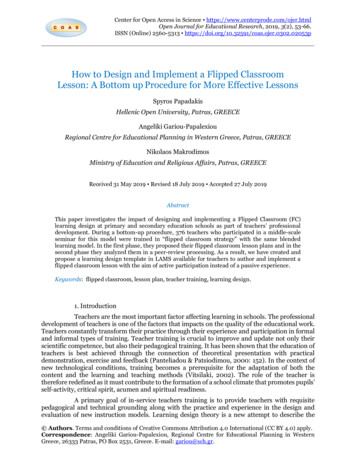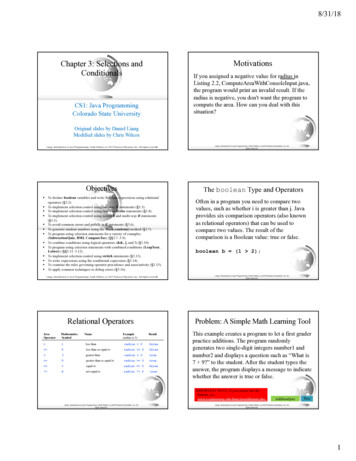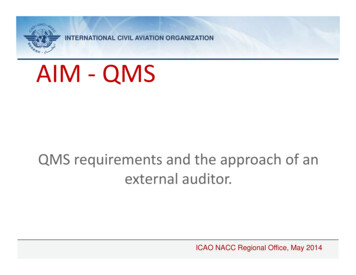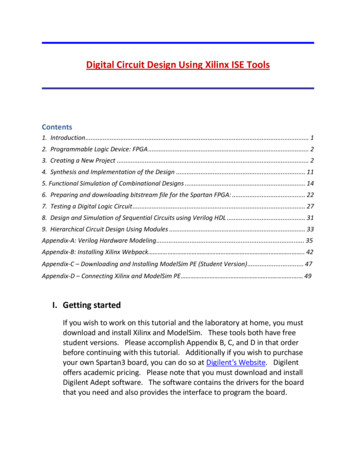
Transcription
Center for Open Access in Science https://www.centerprode.com/ojer.htmlOpen Journal for Educational Research, 2019, 3(2), 53-66.ISSN (Online) 2560-5313 https://doi.org/10.32591/coas.ojer.0302.02053pHow to Design and Implement a Flipped ClassroomLesson: A Bottom up Procedure for More Effective LessonsSpyros PapadakisHellenic Open University, Patras, GREECEAngeliki Gariou-PapalexiouRegional Centre for Educational Planning in Western Greece, Patras, GREECENikolaos MakrodimosMinistry of Education and Religious Affairs, Patras, GREECEReceived 31 May 2019 Revised 18 July 2019 Accepted 27 July 2019AbstractThis paper investigates the impact of designing and implementing a Flipped Classroom (FC)learning design at primary and secondary education schools as part of teachers’ professionaldevelopment. During a bottom-up procedure, 376 teachers who participated in a middle-scaleseminar for this model were trained in “flipped classroom strategy” with the same blendedlearning model. In the first phase, they proposed their flipped classroom lesson plans and in thesecond phase they analyzed them in a peer-review processing. As a result, we have created andpropose a learning design template in LAMS available for teachers to author and implement aflipped classroom lesson with the aim of active participation instead of a passive experience.Keywords: flipped classroom, lesson plan, teacher training, learning design.1. IntroductionTeachers are the most important factor affecting learning in schools. The professionaldevelopment of teachers is one of the factors that impacts on the quality of the educational work.Teachers constantly transform their practice through their experience and participation in formaland informal types of training. Teacher training is crucial to improve and update not only theirscientific competence, but also their pedagogical training. It has been shown that the education ofteachers is best achieved through the connection of theoretical presentation with practicaldemonstration, exercise and feedback (Panteliadou & Patsiodimou, 2000: 152). In the context ofnew technological conditions, training becomes a prerequisite for the adaptation of both thecontent and the learning and teaching methods (Vitsilaki, 2002). The role of the teacher istherefore redefined as it must contribute to the formation of a school climate that promotes pupils’self-activity, critical spirit, acumen and spiritual readiness.A primary goal of in-service teachers training is to provide teachers with requisitepedagogical and technical grounding along with the practice and experience in the design andevaluation of new instruction models. Learning design theory is a new attempt to describe the Authors. Terms and conditions of Creative Commons Attribution 4.0 International (CC BY 4.0) apply.Correspondence: Angeliki Gariou-Papalexiou, Regional Centre for Educational Planning in WesternGreece, 26333 Patras, PO Box 2531, Greece. E-mail: gariou@sch.gr.
S. Papadakis, A. Gariou-Papalexiou & N. Makrodimos – How to Design and Implement .foundational elements of the educational process. Learning designs are “pedagogically informedlearning activities which make effective use of appropriate tools and resources” (Fill, Bailey &Conole, 2008). A learning design describes learning objectives, who does what (and when) usingtools and resources, and outcomes. The field of Learning Design seeks to describe the “process” ofeducation – the sequences of activities facilitated by an educator that are often at the heart of smallgroup teaching (Dalziel, 2007). The traditional lesson plan is not sufficient for the needs of a “flipped classroom”. Taking into account the feedback of the trainee teachers, we have reached the design of a revised lessonplan tailored to the requirements of “flipped classroom”. An effective way of adult learning is the experiential approach, so we have achieved the best results tomeet the “flipped classroom” by using the learning model itself.“Flipped classroom” (FC) is one term used to describe a new pedagogical modelallowing increased instructor-students interaction time and an increase in active-learningopportunities for students in classroom. Flipped learning (FL) is a pedagogical approach in whichthe conventional notion of classroom-based learning is inverted, so that students are introducedto the learning material before class, with classroom time then being used to deepenunderstanding through discussion with peers and problem-solving activities facilitated byteachers (Higher Education Academy).For the implementation of the FC, in most of the cases the use of an “online” platformis required. The inclusion of new technologies in the educational process results in a syncretismthat combines the use of “traditional” methods, such as communication and collaboration in theclassroom, with methods that refer to the use of technological means. This combination ofdifferent educational practices in order to create an improved training program is defined byBersin (2004) as blended learning.The educational platform used was the Learning Activity Management System(LAMS). The LAMS (https://www.lamsfoundation.org/) is the most widespread and popularplatform that implements the ideas of learning design (Dalziel, 2003; Britain, 2004). The LAMSis an Online Free Open Source Software (Papadakis & Paschalis, 2009) that supports the design,authoring, management and supervision of the execution of courses in the form of sequences oflearning activities. LAMS environment was selected due to the diversity of pedagogical tools thatit provides to the authors.In this paper, we present the results of a seven-month study on designing,implementing and evaluating “flipped classroom” pedagogical approaches from teachers inprimary and secondary education. We focused on the effective lesson design adapted to the needsof flipped methodology.We realized that the traditional lesson plan (Greek Pedagogical Institute;Cunningham, 2009) is not sufficient for the needs of a flipped classroom. Thus, we suggested adifferentiated lesson plan. About 200 teachers implemented the differentiated lesson plan in theirflipped class, on different subjects and levels. We collected their feedback on the application, andwe proceeded to re-design the lesson plan. This improved lesson plan designing is presentedbelow.Our research questions include the following:1. Can we have a lesson plan tailored to the requirements of a flippedclassroom?2. What are the improvements that teachers themselves propose for the“flipped” lesson plan after the bottom-up implementation?54
Open Journal for Educational Research, 2019, 3(2), 53-66.Several previous works in the contents of design and implemented flipped classroommodel in K-12 education have been published (Uzunboylu & Karagozlu, 2015; Zainuddin & Halili,2016; Akçayır & Akçayır, 2018).The flipped classroom is an interesting mix of information technology and creativeworking atmosphere in the classroom (Chilingaryan & Zvereva, 2017). The “flipped classroom”provides an opportunity to capture the attention of millennial students and thus improve theirlearning experience. Advocates of the flipped classroom cite the benefits of having students dohands-on activities in the classroom where the instructor can provide a structured context, andstudents can get real-time feedback or assistance working with peers and instructional staff (UNC,2019).Estes et al. (2014) proposed a three-stage model to flip the classroom: (1) the pre-class(modelling, pre-assessment), (2) in-class (clarifying concepts, solving problems), and (3) postclass (assessment, application, transfer) stages. The initial and final stages (pre and post class)were made by students by distance, at home, using a digital platform and appropriate educationalmaterial. Students can view the digital content as many times as they want, they can focus on anypoints they wish, in their own space and their own pace (Strayer, 2007). Thus, the interaction ofstudents with the teaching material is scaled in a way that does not occur when lectures are givenin class (Hertz, 2012). After the “flipped classroom” activities, students can return to the platformand check the level of their knowledge. Depending on their performance and after identifying theirpossible weaknesses, they can refer again to digital material, watch the video again – from adifferent viewpoint – or expand their knowledge further if they wish (Estes et al., 2014). Theintermediate stage (in-class) takes place in the classroom, using active and participatory teachingtechniques (Gariou-Papalexiou et al., 2017). In the “flipped classroom” students are asked tocombine the information they acquired outside the classroom and interact with it and their peersin a way to show that they have become active users of information, based on their personalexperiences, opportunities, critical thinking and interaction through group activities (Bergmannet al., 2011).The need for a new lesson plan design emerges from the differentiation of pre-class,in-class and post-class educational preparation.The literature review shows that lesson designing, as teachers’ responsibility, is one ofthe most important elements in many educational systems all over the world, defining the lessondesigning as the “systematic process of deciding what and how students should learn” (Cicek &Tok, 2014). By trying to analyze the main components of a successful lesson design, we concludewith three main sections: a) the learning objectives or the desired results, b) the learning activitiesand c) the evaluation of understanding or the evidence of learning (Skowron, 2001; Milkova,2012). Starting with the first section, the formulation of the learning objectives properly obtainedhas been mentioned as one of the major problems in lesson designing (Gülten, 2013; Ruys, Keer& Aelterman, 2012; Gafoor & Farooque, 2010). Regarding the second section, researchers claimthat “an effective lesson design focuses primarily on designing the students’ activities rather thandesigning what the teacher will do” (Froelich, 2009).Lesson designing is necessary not only for the basic instruction but for differentinstructional styles like integrated instruction or differentiated instruction or even problem-basedlearning instruction, as well (Skowron, 2001). Although many researchers highlight the greatimportance of lesson designing especially in differentiated instruction, at the same time theyrecognize it as a difficult process (Baker & Fleming, 2005) and emphasize on the need of teachers’collaboration in designing a lesson (Fujii, 2016).55
S. Papadakis, A. Gariou-Papalexiou & N. Makrodimos – How to Design and Implement .2. Research methodologyThis research was conducted in the Regional Training Center of Patras, Greece(http://pek-patras.ach.sch.gr/), at three stages’ seminars.The first seminar entitled “Flipped Classroom and its technological support” wasdesigned and implemented by the authors of this work who had research experience from theapplication of the flipped classroom model, at postgraduate level. Its duration was 40 hours, ofwhich 16 were place-based and 24 by distance. The seminar started at 6 November 2017 and wascompleted on 14 January 2018. The aim of this first seminar was to create 40 educated teachersfor the FC model. Shortly after the completion of the seminar, the 40 educated teachers (19 fromprimary education and 21 from secondary school) were used as trainers in a middle-scale seminarwith the same theme.In the second seminar, 240 teachers were educated in the FC model. Its duration was36 hours, of which 16 were face-to-face and 20 by distance. The seminar was held in 24 schoolunits between February and April 2018. The training teachers formed groups and were then usedas trainers in the third seminar. In this, 96 teachers were educated during 36 hours of training(16h f2f and 20h by distance), between May and June 2018, held in 6 school units (Table 1).Since training is a time-limited intervention, the planners of this training have takeninto account how best to transfer and integrate the acquired learning experience into the learninglife and the working environment of teachers. Thus, the training was implemented on the modelof "Flipped classroom" using the model itself in the process. In total, 376 participants wereeducated in the FC model.Table 1. The general structure of the three-stages’ SeminarNumberofseminarAim ofseminarParticipantsDurationTeachingmethodused1st seminarTo create teachertrainers in FCmodel40 teachers (theywere used astrainers to the 2ndand 3rd seminars)40 hours(16 h on site –24h by distance)FC model2nd seminar3rd seminarTo train classteachers in FCmodelTo train moreclass teachers inFC modelTotal240 class teachers96 class teachers37636 hours(16 h on site –20h by distance)36 hours(16 h on site –20h by distance)40 / 36 hoursFC modelFC modelDuring the second week of their seminar, all the 376 participants of the 3 seminarswere asked to design a lesson plan on a subject of their choice and implement this lesson in theirclass using the FC model. For this purpose, a lesson plan form was given to them to help them indesigning their first lesson with the FC model (Table II).Table 2. Lesson planDateSubjectClassUnitInstructorCognitive aimsLearning outcomesTeaching methodMaterials56
Open Journal for Educational Research, 2019, 3(2), 53-66.Short description of theteaching stagesStudents’ activitiesAssessmentsReferencesThe Learning Activity Management System (LAMS) was used as the main platform forthe communication and implementation of the Seminar work and for the design and developmentof the digital courses.Thus, during the procedure they were asked to transform their lesson plan documentsin a sequence of learning activities (learning design) using the LAMS platform and then uploadtheir lesson plans on the LAMS community. An example is shown below (Figure 1):Figure 1. The design of learning activities of an “English Language – Flipped Classroom” nce?seq id 2215658After the end of the 1st teachers’ training seminar evaluation, the need for a dedicatedFC learning design was raised. Thus, we designed an FC lesson plan template (Table 3).Table 3. Flipped Classroom Lesson Plan TemplateGrade levelSubject areaLesson titleTime neededTeacherNumber of studentsPrerequisite skills or knowledgeLearning objectivesPRE CLASSStudent learning resources with a short description (notes,books, maps, videos, presentations, websites, etc.)Authors of the above learning material and the duration(especially for videos)Student learning activities at home (answering videoembedded questions, solving problems, writing summaries,surveys or essays, etc.)Reviewing students’ work prior to class (through LMSplatforms or other way)57
S. Papadakis, A. Gariou-Papalexiou & N. Makrodimos – How to Design and Implement .Differentiating the design of in class activities depending on theabove feedbackIN CLASSClassroom activities (type, detailed description, duration,materials to prepare)Formative assessmentPOST CLASSSummative assessment through online tests or projectsChallenging activities for high performersAt the end of the seminar, all the participants were asked to evaluate their peers’ lessonplans on the LAMS community and fill a questionnaire with their answers.3. ResultsDuring that medium-range seminar, 276 learning designs (sequences of learningactivities) from teachers were uploaded on the LAMS community (LAMS Central Repository,http://lamscommunity.org/lamscentral/). After that, the teachers were asked to evaluate theabove learning designs by filling in an online form made by the designers of the seminars. Thequestions of the form were based on our flipped classroom learning design template combinedwith the revised Bloom cognitive skills pyramid (Anderson & Krathwohl, 2001, Figure 2).Figure 2. Improving learning to think in a flipping class (Gariou-Papalexiou et al., 2017)The answers of the trainees – evaluators are presented below.3.1 Starting from the base of the pyramid, with the skill of memorizingWriting the cognitive objectives on the lesson plan: Half of the lesson plans (50.4%) were written in a very clear and distinct way. Asa result it was easy to measure the degree of achievement of their cognitiveobjectives. Nearly a third of the plans (37.3%) contained some general goals, makingit more difficult to measure their degree of achievement and only 12.3% plans werewritten in a completely indefinite way (Figure 3).58
Open Journal for Educational Research, 2019, 3(2), 53-66.Figure 3. Formulation of the objectives included in the lesson plansLength of video: Regarding the duration of videos used in the Pre-Class stage of the FlippedClassroom model, as shown by the form answers, it was kept small (from 1 to 9minutes) in the overwhelming majority of projects (86.2%), making it easier forstudents to watch and memorize new information.3.2 Continuing with the cognitive skill of understanding Regarding the kind of cognitive objectives that were included in the lesson plans,almost half of them (44.9%) were knowledge – deepening objectives, while the restof them were equally shared to knowledge – creating objectives and knowledge –acquiring objectives.As to the prerequisite knowledge, no reference is made to the vast majority of thelesson plans, only a small percentage of them (16.3%) refer to the prerequisite knowledge, whereasonly 10% of these plans control the prerequisite knowledge by embedded questions in the videosent at students’ home (Figure 4).Figure 4. Reference of prerequisite knowledge in the lesson plans By examining the degree of interactivity of the videos used in the first stage of theFlipped Classroom model, we observed that almost half of the lesson plans (44.6%)contained videos with few interactive elements, 28.3% of the videos offered no59
S. Papadakis, A. Gariou-Papalexiou & N. Makrodimos – How to Design and Implement .interaction to the students, while 27.3% of the videos activated students with manyinteractive elements such as hyperlinks or embedded questions and tasks.3.3 In the middle of Bloom’s pyramid we come across the skill of application In terms of the number of objectives, the overwhelming majority (79%) of thelesson plans contained few objectives that could be achieved comfortably during thein class time. In the rest of the lesson plans, there was a significant probability thatthe lesson time would not be enough to achieve all the mentioned objectives. With regard to classroom activities, in the second part of the flipped class model,as described in the lesson plans, most of them (45.3%) aim at the higher skills ofassessment and creation, a large proportion of them (40.9%) refers to the Bloom'spyramid middle, in particular the skills of knowledge analysis and application, whileonly a small percentage (13.8%) is limited to the basis of the pyramid and to the skillsof memorization and comprehension. Continuing the assessment of the activities within the class, we observe that inmost of the lesson plans (44.6%) these were exclusively group-based and promotedthe cooperation among the students, a significant proportion of lesson plans (37.7%)contained both individual and group activities and only a small percentage (17.8%)of projects contained exclusively individual activities (Figure 5).Figure 5. Type of in-class activitiesAs far as the skill of the analysis was concerned, the quality of the videos and thesupervision of the teachers over them was examined. Most of the videos (61.2%) used in the first phase of the Flipped Class model wereattractive with rich graphics and clear sound, while almost the rest (35.1%) werejudged to be good for their graphics and sound. Many educational digital platforms such as LAMS provide analytical data onstudent participation and interaction with videos they watch at home. Thismonitoring feature was fully exploited by only a small percentage of teachers (14.1%),while in a small percentage of lesson plans (25.7%) little reference was made to videosupervision, while the majority of lesson plans (60.1%) ignores video supervision andthus, lacks valuable data that could lead to the review and modification of activitieswithin the classroom; like who and how many times watched the video and if thecontent was understood (Figure 6).60
Open Journal for Educational Research, 2019, 3(2), 53-66.Figure 6. Video supervision3.4 The skill of evaluationApproaching the top of Bloom’s pyramid, we examine the cognitive skill of evaluationin the lesson plans:The videos selected for the first stage of the Flipped Classroom modelwere not only short and qualitative but should be appropriate for the lesson to be taught by students. As shown by the lesson plans and the teachers' assessment, thevast majority of the selected videos (67.4%) covered all the cognitive objectives of thecourse, while almost the rest of the videos (28.3%) covered several of the cognitivegoals of the lesson. The great value of lesson plans lies not only in their first use but also in theirability to be reused by other teachers. For this purpose, the activities carried outwithin the classroom should be described in detail. As recorded in the evaluation ofthe lesson plans by the teachers, in their highest proportion (55.8%), the lesson plansdescribed the activities in detail and were accompanied by worksheets so that theycould be reused by other teachers. In a significant proportion of lesson plans (35.1%),activities were briefly described, while in a small percentage of lesson plans (9.1%),classroom activities were recorded only as titles (Figure 7).Figure 7. Description of in class activities in lesson plans61
S. Papadakis, A. Gariou-Papalexiou & N. Makrodimos – How to Design and Implement . More than half of the lesson plans (54.7%) included a complete evaluation oflearning objectives, videos and students’ activities. Only 11.2% of the lesson planswere missing any kind of evaluation.3.5 The skill of creativityplans:At the top of Bloom’s pyramid is creativity. Concerning the videos used in the lesson Only a small percentage (5.1%) of the teachers created their own video from thebeginning, while a significant percentage (28.6%) of them processed a video fromthe Internet by resizing it or embedded questions or even added their voice on it. Themajority of the teachers (66.3%) used an appropriate video from the Internet withno editing at all (Figure 8).Figure 8. Pre-class video editing4. DiscussionThe results of this study clearly show that the structure of the seminar had two strongfoundations. The first concerns the training method. Teaching the flipped class model using themodel itself is innovative and has the advantage that the trainees have personal experience asstudents of the model they are about to teach. The second concerns the redesign of the FC lessonplan after the evaluation of the initial plan. The evaluation from the trainees’ lesson plans for theflipped classroom model lead us t0 design a new lesson design template tailored to the needs ofthe flipped class model.The success of the first part was shown by the efficient use of the first 40 trainees astrainers in the next parts of the seminar (training 366 teachers) and by the successfulimplementation of the flipped classroom model in their classrooms. The second part, based on276 teacher assessments, has led to a satisfactory design of a lesson design template for a flippedclassroom that remains to be tested extensively in practice in future research work.Regarding the results of the lesson plan evaluations, it was expected that our initialhypothesis, that the traditional lesson plan did not fully cover the flipped classroom model, wasright. In particular, as the results are categorized based on the revised Bloom’s Cognitive Pyramid,the deficiencies in the lesson plan are more pronounced at the top of the pyramid regarding thehigher cognitive skills.62
Open Journal for Educational Research, 2019, 3(2), 53-66.Most trainees were experienced teachers and knew that the cognitive objectives of thelesson plan should be few and clearly written so that their degree of achievement could be easilymeasured. As to the quality of the objectives, only half of the lesson plans were aimed at deepeningknowledge and creation. What was noteworthy was that most of the projects lacked reference toprerequisite knowledge and skills which is supposed to be the critical key to the success of everylesson. On the other hand, almost all trainees had already learned from the seminar theory andtheir own experience that the videos sent to their students should be short, attractive, appropriateand interactive.Confirming the change of the latest years in the Greek educational community, thevast majority of lesson plans included group cooperative activities within the classroom. Thedisappointing results with regard to the feedback that teachers could get from digital platformssuch as LAMS and Edpuzzle, which are widely used in the flipped classroom model, can beexplained by the fact that most teachers were not familiar with the use of this model and it wastheir first time they could have feedback before the class.Almost half of the teachers had foreseen in their lesson plans to evaluate, after thelesson, achievement of cognitive goals, video success and classroom activities.In terms of creativity, only a few teachers created their own videos from the beginning,perhaps because of a lack of technical knowledge or insecurity, a small percentage of themprocessed the videos they used, while most of them preferred the confidence of the educationalvideos found on the Internet.Figure 9. Flipped Classroom Learning Design Template Example in LAMS5. ConclusionsThe information we have gathered in this study leads to the conclusion that thetraditional lesson plan is not sufficient for the needs of a flipped classroom. We focused on theeffective lesson design adapted to the needs of flipped methodology. The whole methodology wasapplied to a wide variety of levels and objects. More specifically, the study was implemented in63
S. Papadakis, A. Gariou-Papalexiou & N. Makrodimos – How to Design and Implement .both primary and secondary education, as well as vocational education. In addition, researchcovers a medium-scale process in different disciplines.In addition, an effective way of adult learning is the experiential approach, so we haveachieved the best results to meet the “flipped classroom” by using the learning model itself.Taking into account the feedback of the trainee teachers, we have reached the designof a revised lesson plan tailored to the requirements of a flipped classroom. We propose that therevised lesson plan be used and further tested to flipped classroom lessons. We recommend its usein lessons designed by the flipped class model combined with differentiated strategies or projectbased learning or game based learning. This revised lesson plan should be tested in “flippedclasses” all over the school year if it is possible in combination with differentiated teaching.Acknowledgementsediting.We would like to thank Mrs. Seraphia Savvaidou for her contribution to the EnglishThis research did not receive any specific grant from funding agencies in the publiccommercial, or nonprofit sectors.The authors declare no competing interests.ReferencesAnderson, L.W., & Krathwohl, I. (2001). A taxonomy for learning, teaching, and assessing: A revision ofBloom’s taxonomy of educational objectives. New York: Longman.Baker, P.H., & Fleming, L. C. (2005). Lesson plan design for facilitating differentiated instruction. MidWestern Educational Researcher, 28(4), 35-44.Bergmann, J., Overmyer, J., & Wilie, B. (2011). The flipped class: Myths vs. reality. Retrieved ped-class-conversation-689.php.Bersin, J. (2004). The blended learning book: Best practices, proven methodologies, and lessons learned.San Francisco, CA: Pfeiffer.Britain, S. (2004). A review of learning design: Concept, specifications and tools. A report for the JISC Elearning Pedagogy Programme. Retrieved from:www.elearning.ac.uk/subjects/ldfold/LD/topic view.Cicek, V., & Tok, H. (2014). Effective use of lesson plans to enhance education in us and Turkishkindergarten thru 12th grade public school system: a comparative study. International Journalof Teaching and Education, 2(2), 10-20.Chilingaryan, K., & Zvereva, E. (2017). Methodology of flipped classroom as a learning technology in foreignlanguage teaching. Procedia – Social and Behavioral Sciences, 237, 1500-1504.Cunningham, G. (2009). Lesson plans and unit plans: The basis for instruction. In: The new teacher’scompanion: practical wisdom for succeeding in the classroom, chapter 7. ASCD.Dalziel, J. (2003). Implementing learning design: The Learning Activity Management System (LAMS),Sydney: E-learning Centre of Excellence (MELCOE), Macquarie University. Retrieved 0Dalziel%20Final.pdf.Dalziel, J. (2007). Using LAMS for inquiry-based learning: Keynote presentation for the centre for inquirybased learning in the arts and social sciences (CILASS). Presentation given at LAMS Workshop,64
Open Journal for Educational Research, 2019, 3(2), ch/go-to-attachment?object id 443758&attachment id 443760.Estes, M. D., Ingram, R., Liu, J. C. (2014). A review of flipped classroom research, practice, and technologies.International HETL Review, 4(7). Retrieved from: s.Fill, K., Bailey, C., & Conole, G. (2008). A toolkit to guide the design of effectiv
propose a learning design template in LAMS available for teachers to author and implement a flipped classroom lesson with the aim of active participation instead of a passive experience. Keywords: flipped classroom, lesson










